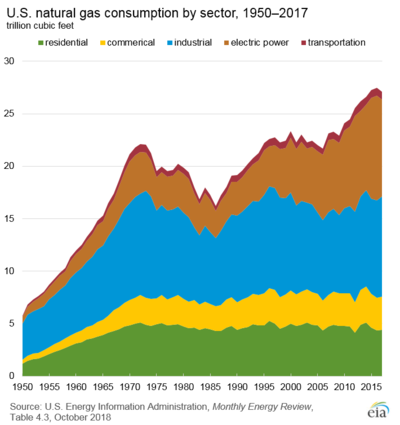
Natural gas is a gas composed of methane, with other hydrocarbons, carbon dioxide, nitrogen and hydrogen sulfide. The gas occurs naturally in underground cavities in many locations on Earth. It is often found at locations where petroleum too is present.
Before it can be used as a fuel, it must undergo processing to clean the gas and remove impurities including water in order to meet the specifications of marketable natural gas. The by-products of processing include ethane, propane, butanes, pentanes, and higher molecular weight hydrocarbons, hydrogen sulphide (which may be converted into pure sulfur), carbon dioxide, water vapor, and sometimes helium and nitrogen. It is this huge diversity in products that can be made from natural gas that has made it quite popular.
The use of natural gas has been steadily increasing in result of new technologies in the fracking industry. These new fracking technologies have drastically decreased the price by increasing the amount of reserves and decreasing the amount of labor and capital associated with fracking for natural gas. Since, there has been a decrease in the price of natural gas, it has been replacing coal power plants in the United States and has also increased the amount profitable oil fields that can now be fracked. One of the biggest draw backs of natural gas are the dangers that are associated with it. These dangers range from carbon emissions further progressing climate change, the negative health effects associated with the water quality that is a result of nearby fracking to accidental gas explosions.
Extraction[edit | edit source]

Fracking is the primary process used to extract natural gas out of the earth. When natural gas is fracked there is a lengthy process that goes into refining the gas to the point so that it can be used as a fuel for power plants and appliances. When natural gas is extracted from a well it is called, wet natural gas. The name wet natural gas comes from there often being liquid hydrocarbons and non hydrocarbons in the gas.[1] The Unites States as of the year 2016 has about 2,462 trillion cubic feet (tcf) of technically recoverable resources of dry natural gas in the United States. At the rate of U.S. natural gas consumption in 2016 of about 27.5 tcf per year, the United States has enough natural gas to last about 90 years. Given that natural gas consumption use will not remain the same for years to come the actual number of years will depend on the amount of natural gas consumed each year, natural gas imports and exports, and additions to natural gas reserves.[2] A big factor that has the potential to drastically decrease the United States natural gas consumption are solar and wind replacing natural gas in the U.S.'s grid energy mix. Along with renewable's replacing natural gas power plants, the electrification movement is another threat. The electrification movement is the implementation of all electric houses for existing buildings and new construction.
Delivery and storage[edit | edit source]
Transporting natural gas from the wellhead to consumers requires many infrastructure assets and processing steps, and it includes several physical transfers of custody. Natural gas delivery can be broken down into processing, transportation and storage. A natural gas processing plant typically receives natural gas from a gathering system of pipelines from natural gas and oil wells. The processing plants have a wide array of containments they remove that include oil, water, HGL, and other impurities such as sulfur, helium, nitrogen, hydrogen sulfide, and carbon dioxide. The composition of the wellhead natural gas determines the number of stages and the processes required to produce pipeline-quality dry natural gas. These processes and stages may be integrated into one unit or operation and might be performed in a different order depending on the processing plant. Natural gas can also be stored for times of peak demand, which fluctuates daily and seasonally, while production and pipeline imports are relatively constant in the short term. Storage of natural gas during periods of low demand helps to ensure that sufficient supplies of natural gas are available during periods of high demand.[3]
Liquified Natural Gas[edit | edit source]
As described above, the distribution of natural gas is typically only feasible via pipeline distribution. Since natural gas is a light and gaseous substance this is the only way it can be transported while minimizing supply loss. This means that the natural gas market cannot be considered a global market and is often described by varying independent price ranges from country to country and especially from continent to continent. The only means of transporting natural gas overseas to expand the global market is through liquified natural gas. Liquified natural gas (LNG) is natural gas that has been cooled down to a liquid state at about -20 degrees Fahrenheit. This allows for the natural gas to increase in mass and density and thus makes it much easier to transport in large quantities over long distances. Since the volume of natural gas is about 600 times smaller in liquid form than it is in it's gaseous state this makes it even more possible to transport in large quantities. For large-volume ocean transport LNG is loaded onto larger double hulled tanker ships. Once the gas reaches the offloading site the LNG is loaded into storage tans and then later degasified and redistributed back into the pipeline system. LNG is also transported in smaller quantities over shorter ocean distances using the same containers used on trucks and in international trade, specially outfitted with cryogenic tanks. Small-scale LNG also includes peak-shaver liquefaction and storage facilities capable of storing natural gas for use in the US or local markets in times of peak demand. In 2020 the US exported 2400 billion cubic feet of LNG in larger LNG tanker ships delivering to 40 countries on five continents.[4]
Usage[edit | edit source]
As mentioned above the United States used about 27 trillion cubic feet (Tcf) of natural gas in 2017, which is 29% of the total U.S. primary energy consumption. Natural gases usage by sector is composed of industrial, electric power, residential, commercial and transportation. The industrial sector uses natural gas for process heating, combined heat and power systems, as a raw material (feedstock) to produce chemicals, fertilizer, and hydrogen. As for the residential sector natural gas uses vary from heat buildings and water, to cooking, and to drying clothes. About half of the homes in the United States use natural gas for these purposes and accounts for about 23% of the U.S. residential sector's total energy consumption. In the commercial sector the primary use of natural gas is for heating buildings and water, to operate refrigeration and cooling equipment and to cook. Lastly, the transportation sectors use of natural gas mainly stems from the the use of natural gas to operate compressors. These compressors move natural gas through pipelines, which allow the delivery of natural gas to utilities.[5]
Costs[edit | edit source]
The price that consumers pay for natural gas is primarily composed of three different types of costs. These costs are commodity costs, transmission cost and a distribution cost. A commodity cost is the price of the natural gas itself. The transmission and distribution costs originates from the price that utilities charge the consumers for storing and transporting the natural gas. Retail prices for natural gas varies greatly based on geography. Some factors that affect the retail price of natural gas that are geography based are how far away the natural gas is produced or stored from the burner, the amount of natural gas that can be moved from producing areas, storage facilities, and trading hubs to distribution hubs and lastly how competitive the local natural gas market it is.[6] A key aspect to the costs associated with natural gas that can't be overlooked is how much setting up a gas connection to a house costs. For new construction an all electric home will on average be about three to five thousand dollars cheaper than a gas and electric house.
Life Cycle Assessment[edit | edit source]
Natural gas is often to thought to be a cleaner fuel than coal in regards to the carbon intensity of each fuel. When just comparing the tailpipe emissions this is the case. However, in order for natural gas power plants to have a lower carbon intensity than coal fired power plants the methane leakage rate has to be under 3.2%. The state of California has an average methane leakage rate that is estimated to be anywhere from 3-5%. California's natural gas infrastructure is one of the less leaky systems in the world. The natural gas infrastructure that connects the Middle East to Europe are estimated to be twice as leaky, which puts their leakage rates at 6-10%. Natural gas leaking is a big concern because natural gas is primarily composed of methane, which on a 100 year timescale is 34 times more potent than carbon dioxide and on a 20 year time scale has 86 times the global warming potential than carbon dioxide.[7]
See also[edit | edit source]
External links[edit | edit source]
- ↑ https://www.eia.gov/energyexplained/index.php?page=natural_gas_home
- ↑ https://www.eia.gov/tools/faqs/faq.php?id=58&t=8
- ↑ https://www.eia.gov/energyexplained/index.php?page=natural_gas_delivery
- ↑ https://www.energy.gov/fecm/liquefied-natural-gas-lng
- ↑ https://www.eia.gov/energyexplained/index.php?page=natural_gas_use
- ↑ https://www.eia.gov/energyexplained/index.php?page=natural_gas_prices
- ↑ https://www.ucsusa.org/clean-energy/coal-and-other-fossil-fuels/environmental-impacts-of-natural-gas#.W_3KhZyQGUk